Udaipur Landmarks, Temples and Monuments
(Udaipur, Rajasthan, India)
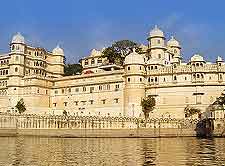
There are some quite remarkable landmarks dotted around Udaipur, which draw literally thousands of visitors to this colourful city each year, who come to marvel at spectacular sights, such as the City Palace and the Lake Palace. Other unique landmarks in Udaipur include the Jagdish Temple, the Neemach Mata Temple and also the Bagore-Ki-Haveli.
The Sajjangarh Fort is another very noteworthy landmark and served as a favourite summer resort for local Indian maharajas. Standing on the very top of a rocky hill, the Sajjangarh Fort enjoys some spectacular views across Udaipur, the Fateh Sagar Lake and the surrounding marble palaces, a number of which have recently been converted into leading hotels.
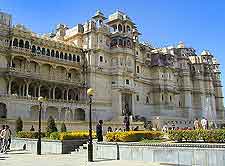
City Palace
Towering high above the adjacent Lake Pichola and remaining the biggest palace complex in the whole of the Indian state of Rajasthan, the City Palace boasts a facade which is almost 250 metres / 820 feet in length, and is just over 30 metres / 98 feet in height. The Udaipur City Palace is made up of a series of different buildings, built by ruling maharajas, which all manage to successfully combine to make one magnificent landmark, which is well known for its appearance in the James Bond classic, Octopussy. Created by the founder on Udaipur, the Maharaja Udai Singh II, the City Palace enjoys stunning lakeside views, and can be entered either through the Baripol Gate or the Tripolia Gate, which date from the early 17th and 18th centuries respectively. Highlights include a popular museum, Manak Mahal ruby glasswork, a central Bari Mahal garden, Indian art works in the Zenana Mahal, and an interesting cage used to catch tigers, which is situated next to the Zenana Mahal entrance.
Open hours: daily
Admission: charge
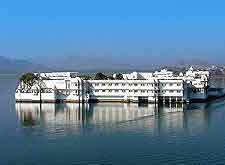
Lake Palace
One of the most stunning landmarks in Udaipur, the Lake Palace is enhanced further by its very beautiful setting, on the Jagniwas Island, within Lake Pichola itself. Formerly serving the Maharaja Jagat Singh II as a private residence and pleasance palace, the marble 18th-century architecture of the Lake Palace gracefully reflects in the waterfront, while the Aravalli Mountains add to the overall scenery. Today, the palace is actually owned by the Taj Hotel Group and provides luxury accommodation at its very best.
Open hours: daily
Admission: free
Sajjangarh Fort (Sajjangarh Palace)
The Sajjangarh Palace was built to be used as an observatory, from where the Maharana Sajjan Singh was able to see the arriving monsoon clouds from afar. Although it is possible to reach this imposing landmark by car, the leisurely boat trip is recommended, since it features superb views from the southern side of the lake. Close by, the Sajjan Niwas Garden may also be of interest.
Open hours: daily
Admission: charge
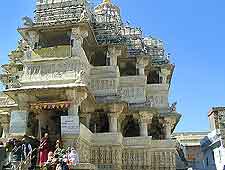
Jagdish Temple (Sri Jagadishji Temple)
The Jagdish Temple resides just a matter of metres to the north of the entrance to the City Palace and is amongst the city's most noteworthy landmarks, thanks in no small part to its imposing Indo-Aryan architecture and highly detailed carvings. Built in the middle of the 17th century at the request of the Maharajah Jagat Singh, the Jagdish Temple is home to a number of important sculptures, depicting Vishnu as Jagannath (Lord of the Universe) and also Garuda, which is located within the shrine at the very front and made of brass.
Open hours: daily - 05:00 to 14:00, 16:00 to 22:30
Admission: free
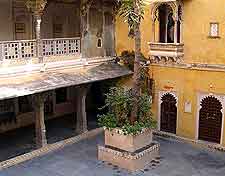
Bagore-Ki-Haveli
The Bagore-Ki-Haveli is an especially grand haveli (Indian residence) and dates from the 18th century, being situated on the waterfront and within the Gangaur Ghat area. Constructed by a former Indian prime minister and recently restored, the Bagore-Ki-Haveli has become a favourite local landmark and contains almost 140 different rooms, which are arranged around a series of courtyards. Look out for the largest turban in the world, the art gallery, the famous polystyrene monuments, and the upper courtyard, where Rajasthani dancing often takes place.
Open hours: daily - 10:00 to 19:00
Admission: charge
Neemach Mata Temple
The Neemach Mata Temple boasts an enviable elevated hilltop setting and the main reason that so many visitors come here each year is simply that it offers the very best views of Udaipur imaginable. Therefore, you are strongly advised to bring your camera here. The Neemach Mata Temple is sited within the Dewali area and can be reached via either a steep stairway, or alternatively up a more gradual slope, which is around 800 metres / 2,625 feet in length. This is one not to miss under any circumstances.
Open hours: daily
Admission: free
 There are some quite remarkable landmarks dotted around Udaipur, which draw literally thousands of visitors to this colourful city each year, who come to marvel at spectacular sights, such as the City Palace and the Lake Palace. Other unique landmarks in Udaipur include the Jagdish Temple, the Neemach Mata Temple and also the Bagore-Ki-Haveli.
There are some quite remarkable landmarks dotted around Udaipur, which draw literally thousands of visitors to this colourful city each year, who come to marvel at spectacular sights, such as the City Palace and the Lake Palace. Other unique landmarks in Udaipur include the Jagdish Temple, the Neemach Mata Temple and also the Bagore-Ki-Haveli.


